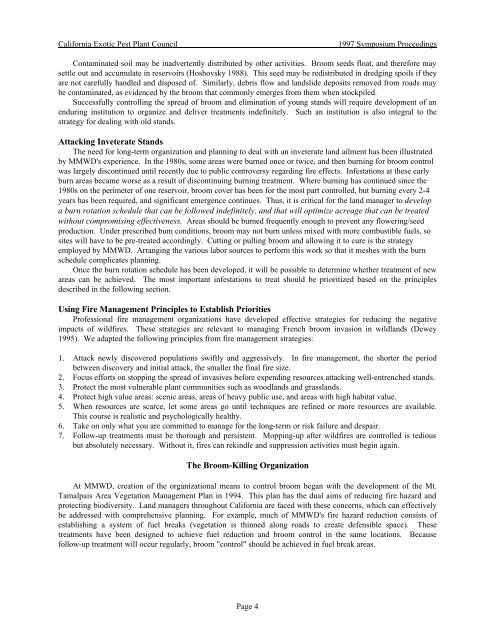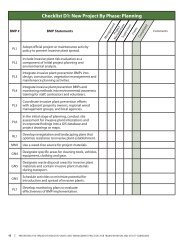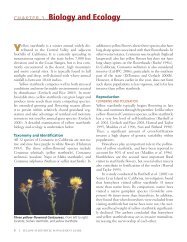Fire on the Mountain*: a Land Manager's Manifesto for ... - Cal-IPC
Fire on the Mountain*: a Land Manager's Manifesto for ... - Cal-IPC
Fire on the Mountain*: a Land Manager's Manifesto for ... - Cal-IPC
Create successful ePaper yourself
Turn your PDF publications into a flip-book with our unique Google optimized e-Paper software.
<strong>Cal</strong>i<strong>for</strong>nia Exotic Pest Plant Council1997 Symposium ProceedingsC<strong>on</strong>taminated soil may be inadvertently distributed by o<strong>the</strong>r activities. Broom seeds float, and <strong>the</strong>re<strong>for</strong>e maysettle out and accumulate in reservoirs (Hoshovsky 1988). This seed may be redistributed in dredging spoils if <strong>the</strong>yare not carefully handled and disposed of. Similarly, debris flow and landslide deposits removed from roads maybe c<strong>on</strong>taminated, as evidenced by <strong>the</strong> broom that comm<strong>on</strong>ly emerges from <strong>the</strong>m when stockpiled.Successfully c<strong>on</strong>trolling <strong>the</strong> spread of broom and eliminati<strong>on</strong> of young stands will require development of anenduring instituti<strong>on</strong> to organize and deliver treatments indefinitely. Such an instituti<strong>on</strong> is also integral to <strong>the</strong>strategy <strong>for</strong> dealing with old stands.Attacking Inveterate StandsThe need <strong>for</strong> l<strong>on</strong>g-term organizati<strong>on</strong> and planning to deal with an inveterate land ailment has been illustratedby MMWD's experience. In <strong>the</strong> 1980s, some areas were burned <strong>on</strong>ce or twice, and <strong>the</strong>n burning <strong>for</strong> broom c<strong>on</strong>trolwas largely disc<strong>on</strong>tinued until recently due to public c<strong>on</strong>troversy regarding fire effects. Infestati<strong>on</strong>s at <strong>the</strong>se earlyburn areas became worse as a result of disc<strong>on</strong>tinuing burning treatment. Where burning has c<strong>on</strong>tinued since <strong>the</strong>1980s <strong>on</strong> <strong>the</strong> perimeter of <strong>on</strong>e reservoir, broom cover has been <strong>for</strong> <strong>the</strong> most part c<strong>on</strong>trolled, but burning every 2-4years has been required, and significant emergence c<strong>on</strong>tinues. Thus, it is critical <strong>for</strong> <strong>the</strong> land manager to developa burn rotati<strong>on</strong> schedule that can be followed indefinitely, and that will optimize acreage that can be treatedwithout compromising effectiveness. Areas should be burned frequently enough to prevent any flowering/seedproducti<strong>on</strong>. Under prescribed bum c<strong>on</strong>diti<strong>on</strong>s, broom may not burn unless mixed with more combustible fuels, sosites will have to be pre-treated accordingly. Cutting or pulling broom and allowing it to cure is <strong>the</strong> strategyemployed by MMWD. Arranging <strong>the</strong> various labor sources to per<strong>for</strong>m this work so that it meshes with <strong>the</strong> burnschedule complicates planning.Once <strong>the</strong> burn rotati<strong>on</strong> schedule has been developed, it will be possible to determine whe<strong>the</strong>r treatment of newareas can be achieved. The most important infestati<strong>on</strong>s to treat should be prioritized based <strong>on</strong> <strong>the</strong> principlesdescribed in <strong>the</strong> following secti<strong>on</strong>.Using <str<strong>on</strong>g>Fire</str<strong>on</strong>g> Management Principles to Establish PrioritiesProfessi<strong>on</strong>al fire management organizati<strong>on</strong>s have developed effective strategies <strong>for</strong> reducing <strong>the</strong> negativeimpacts of wildfires. These strategies are relevant to managing French broom invasi<strong>on</strong> in wildlands (Dewey1995). We adapted <strong>the</strong> following principles from fire management strategies:1. Attack newly discovered populati<strong>on</strong>s swiftly and aggressively. In fire management, <strong>the</strong> shorter <strong>the</strong> periodbetween discovery and initial attack, <strong>the</strong> smaller <strong>the</strong> final fire size.2. Focus ef<strong>for</strong>ts <strong>on</strong> stopping <strong>the</strong> spread of invasives be<strong>for</strong>e expending resources attacking well-entrenched stands.3. Protect <strong>the</strong> most vulnerable plant communities such as woodlands and grasslands.4. Protect high value areas: scenic areas, areas of heavy public use, and areas with high habitat value.5. When resources are scarce, let some areas go until techniques are refined or more resources are available.This course is realistic and psychologically healthy.6. Take <strong>on</strong> <strong>on</strong>ly what you are committed to manage <strong>for</strong> <strong>the</strong> l<strong>on</strong>g-term or risk failure and despair.7. Follow-up treatments must be thorough and persistent. Mopping-up after wildfires are c<strong>on</strong>trolled is tediousbut absolutely necessary. Without it, fires can rekindle and suppressi<strong>on</strong> activities must begin again.The Broom-Killing Organizati<strong>on</strong>At MMWD, creati<strong>on</strong> of <strong>the</strong> organizati<strong>on</strong>al means to c<strong>on</strong>trol broom began with <strong>the</strong> development of <strong>the</strong> Mt.Tamalpais Area Vegetati<strong>on</strong> Management Plan in 1994. This plan has <strong>the</strong> dual aims of reducing fire hazard andprotecting biodiversity. <strong>Land</strong> managers throughout <strong>Cal</strong>i<strong>for</strong>nia are faced with <strong>the</strong>se c<strong>on</strong>cerns, which can effectivelybe addressed with comprehensive planning. For example, much of MMWD's fire hazard reducti<strong>on</strong> c<strong>on</strong>sists ofestablishing a system of fuel breaks (vegetati<strong>on</strong> is thinned al<strong>on</strong>g roads to create defensible space). Thesetreatments have been designed to achieve fuel reducti<strong>on</strong> and broom c<strong>on</strong>trol in <strong>the</strong> same locati<strong>on</strong>s. Becausefollow-up treatment will occur regularly, broom "c<strong>on</strong>trol" should be achieved in fuel break areas.Page 4
















